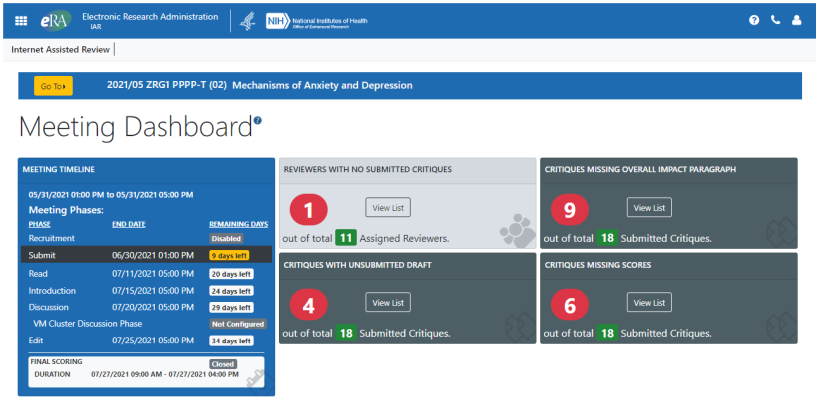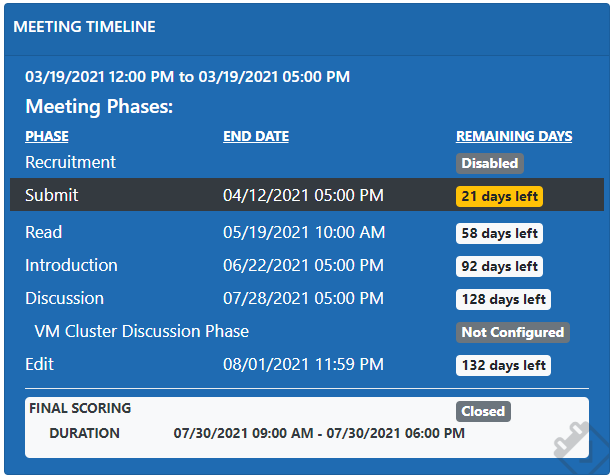General Information (Top Section)
The top section of the Meeting Dashboard shows high level information related to a meeting that is utilizing online critiques, including the timeline and key critique submission indicators.

The Meeting Dashboard provides key information on:
-
MEETING TIMELINE. Contains dates and times for IAR phases.
-
The current phase is highlighted with a black bar.
-
The Recruitment Phase is labeled ‘Enabled’ or ‘Disabled,’ depending on whether the SRO has set up the phase in the Peer Review Recruitment Control Center.
-
For Submit, Read, and Edit phases, REMAINING DAYS displays 'Completed' if the phase is past.
-
If the Submit, Read, or Edit phase is ending in the future, it displays 'x days left' with the number of days for 'x'. If the phase is ending the same day that you opened the Meeting Dashboard, then it displays 'Ending Soon'.
-
In the
 Meeting Timeline for virtual meetings, you also see the phases relevant to virtual meetings—Introduction and Discussion—and their remaining days left.
Meeting Timeline for virtual meetings, you also see the phases relevant to virtual meetings—Introduction and Discussion—and their remaining days left. -
Also showing for virtual meetings is VM Cluster Discussion Phase, which has one of three values:
Configured. At least one cluster discussion phase has been set up.
Not Configured. No cluster discussion phase has been set up.
Completed. The parent discussion phase has been completed.
-
The duration of Final Scoring and whether it is open or closed is also listed.
-
-
REVIEWERS WITH NO SUBMITTED CRITIQUES. The number of reviewers who have not submitted even one of their assigned critiques is listed, along with the total number of reviewers who are enabled by the SRO for the meeting and who have at least one assigned critique. If a reviewer has submitted at least one of their assigned critiques, then the reviewer is not counted in this statistic, even if that reviewer has multiple critiques assigned. Click this section's View List button to see the list of reviewers with no submitted critiques in the third section of this dashboard.
-
CRITIQUES WITH UNSUBMITTED DRAFTS. The number of critiques which were submitted earlier but the reviewer started editing the critique after submission, leaving it in draft mode. The reviewer might have meant to submit the updates and have forgotten to do so. The card also indicates how many total submitted critiques, which is the total individual critiques that have been filled out and submitted. For example, if five reviewers were assigned two critiques each (10 assignments), and all five reviewers filled out and submitted one critique, then total submitted critiques would be five. Click this section's View List button to see the list of critiques with unsubmitted drafts in the third section of this dashboard.
-
CRITIQUES MISSING OVERALL IMPACT PARAGRAPH. The number of submitted critiques for which reviewer did not fill out the overall impact paragraph of the application, a required item. This card also indicates total submitted critiques. Click this section's View List button to see the list of critiques missing overall impact in the third section of this dashboard.
-
CRITIQUES MISSING SCORES. The number of submitted critiques in which the reviewer has omitted entering scores. This card also indicates total submitted critiques. Click this section's View List button to see the list of critiques missing scores in the third section of this dashboard.

